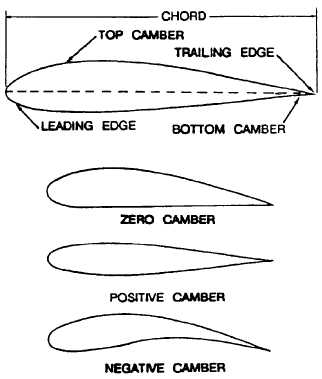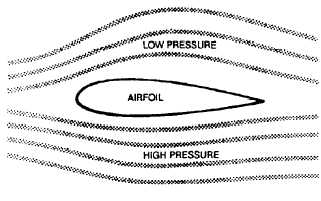*TM 1-1500-204-23-5
1-2
Change 3
Figure
1-2. Airfoil features.
b.
Bernoulli’s Principle. Bernoulli, an eighteenth
century physicist, discovered that air moving over a sur-
face decreases air pressure on the surface (Figure 1-3).
As air speed increases, surface air pressure decreases
accordingly. This is directly related to the flight of an
aircraft. As an airfoil starts moving through the air, it di-
vides the mass of air molecules at its leading edge. The
distance across the curved top surface is greater than
that across the relatively flat bottom surface. Air mole-
cules that pass over the top must therefore move faster
than those passing under the bottom in order to meet at
the same time along the trailing edge. The faster airflow
across the top surface creates a low-pressure area
above the airfoil. Air pressure below the airfoil is greater
than the pressure above it and tends to push the airfoil
up into the area of lower pressure. As long as air passes
over the airfoil, this condition will exist. It is the difference
in pressure that causes lift. When air movement is fast
enough over a wing or rotor blade, the lift produced
matches the weight of the airfoil and its attached parts.
This lift is able to support the entire aircraft. As airspeed
across the wing or rotor increases further, the lift exceeds
the weight of the aircraft and the aircraft rises. Not all of
the air met by an airfoil is used in lift. Some of it creates
resistance, or drag, that hinders forward motion. Lift and
drag increase and decrease together. They are therefore
affected by the airfoil’s angle of attack into the air, the
speed of airflow, the air density, and the shape of the
airfoil or wing.
Figure
1-3. Bernoulli’s principle.
c.
Lift and Thrust. The amount of lift that an airfoil
can develop depends on five major factors:
D Area (size or surface area of the airfoil).
D Shape (shape or design of the airfoil sections).
D Speed (velocity of the air passing over the airfoil).
D Angle of attack (angle at which the air strikes the
airfoil).
D Air density (amount of air in a given space).
(1)
Area and Shape. The specific shape and
surface area of an airfoil are determined by the aircraft
manufacturer. An airfoil may be symmetrical or unsym-
metrical, depending on specific requirements. A sym-
metrical airfoil is designed with an equal amount of cam-
ber
above
and
below
the
airfoil
chord
line.
An
unsymmetrical airfoil has a greater amount of camber
above the chord line. An airfoil with a smooth surface
produces more lift than one with a rough surface. A rough
surface creates turbulence, which reduces lift and in-
creases drag.
(2)
Speed. The speed of an airfoil can be
changed by the speed of the engine or by the angle of the
blade. The lift developed by an airfoil increases as speed
increases. However, there is a limit to the amount of lift
because the drag (resistance) of the airfoil also increases
as speed increases.
(3)
Angle of Attack. The angle of attack is the
angle between the airfoil chord and the direction of rela-
tive wind. Direction of airflow in relation to the airfoil is
called relative wind. Lift increases as the angle of attack



